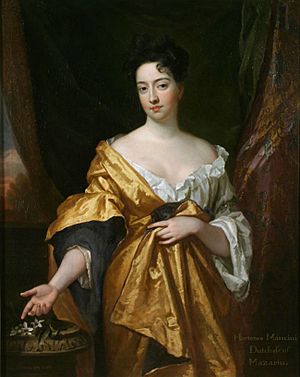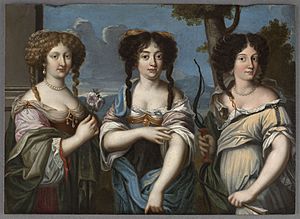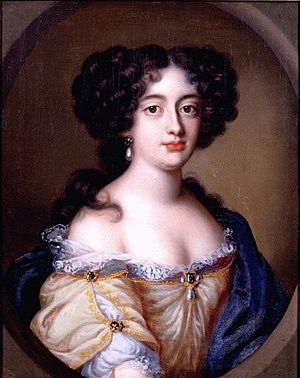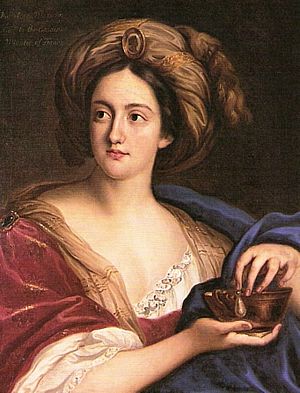Hortense Mancini facts for kids
Quick facts for kids Hortense Mancini |
|||||
|---|---|---|---|---|---|
| Duchess of La Meilleraye suo jure Duchess of Mazarin |
|||||

Portrait by Sir Godfrey Kneller c. 1671
|
|||||
| Born | 6 June 1646 Rome, Papal States |
||||
| Died | 2 July 1699 (aged 53) | ||||
| Spouse |
Armand Charles de La Porte de La Meilleraye
(m. 1661; sep. 1668) |
||||
| Issue | Marie Charlotte, Duchess of Aiguillon Marie Olympe, Marquise of Bellefonds Paul Jules, 3rd Duke of La Meilleraye |
||||
|
|||||
| Father | Lorenzo Mancini | ||||
| Mother | Girolama Mazzarini | ||||
Hortense Mancini, Duchess of Mazarin (born June 6, 1646 – died July 2, 1699), was a very important woman in French and English history. She was the niece of Cardinal Mazarin, who was the chief minister of France. Hortense was also a close companion to King Charles II of England.
She was the fourth of five famous Mancini sisters. These sisters, along with two of their cousins, were known as the Mazarinettes at the court of King Louis XIV of France. They were famous for their beauty and for making good marriages.
Contents
Hortense's Early Life and Family
Hortense was born in Rome, Italy. Her birth name was Ortensia. Her father was Baron Lorenzo Mancini, an Italian nobleman. After her father passed away in 1650, her mother, Girolama Mazzarini, brought her daughters to Paris. Her mother hoped that her brother, Cardinal Mazarin, would help them find good husbands.
Hortense had four well-known sisters:
- Laura (1636–1657) married Louis de Bourbon. She became the mother of a famous French general, Louis Joseph de Bourbon, duc de Vendôme.
- Olympe (1638–1708) married Prince Eugène-Maurice of Savoy-Carignano. She was the mother of the famous Austrian general Prince Eugene of Savoy.
- Marie (1639–1715) married Prince Lorenzo Onofrio Colonna. She was also the first person King Louis XIV of France ever fell in love with.
- Marie Anne (1649–1714) married Godefroy Maurice de La Tour d'Auvergne, Duke of Bouillon. He was a nephew of the famous military leader Turenne.
Their cousins, the Martinozzis, also came to France to find good marriages.
- The older cousin, Anne Marie Martinozzi, married Armand de Bourbon.
- The younger cousin, Laura, married Alfonso IV d'Este, the Duke of Modena. She became the mother of Mary of Modena, who was the second wife of James II of England.
The Mancini family also had three brothers: Paul, Philippe, and Alphonse.
Marriage Offers for Hortense
In 1659, Charles II of England, who was a cousin of Louis XIV, asked to marry Hortense. But Cardinal Mazarin said no. He thought Charles, who was living in exile at the time, didn't have much of a future.
Mazarin soon realized his mistake when Charles became King of England just a few months later. Mazarin then offered a huge amount of money, 5 million livres, as a dowry for Hortense. But Charles refused the offer. Even though they didn't marry, their paths would cross again later.
Hortense was also considered for marriage by Charles Emmanuel II, Duke of Savoy. He was another cousin of Louis XIV. However, this plan also failed because Cardinal Mazarin would not include a castle called Pignerol in her dowry. An offer from the Duke of Lorraine also fell through for similar reasons.
Hortense's Difficult Marriage
On March 1, 1661, when Hortense was fourteen, she married Armand Charles de La Porte de La Meilleraye. He was one of the richest men in Europe. When he married Hortense, he was given the title of duc Mazarin. After Cardinal Mazarin died, Armand-Charles received his wife's huge inheritance. This included the Palais Mazarin in Paris, which held many beautiful artworks.
However, their marriage was not a happy one. Hortense was young, smart, and well-liked. Armand-Charles was very careful with money and extremely jealous. He also seemed to have some mental health issues. He did not allow Hortense to spend time with other men. He insisted she pray for a quarter of each day. He even forced her to leave Paris and move with him to the countryside.
Despite their problems, Hortense and her husband had four children:
- Marie Charlotte de La Porte (born March 28, 1662 – died May 13, 1729) married Louis Armand de Vignerot du Plessis, duc d'Aiguillon.
- Marie Anne de La Porte (born 1663 – died October 1720) became an abbess, a leader in a convent.
- Marie Olympe de La Porte (born 1665 – died January 24, 1754) married Louis Christophe Gigault.
- Paul Jules de La Porte de La Meilleraye (born January 25, 1666 – died September 7, 1731) married Félice Armande Charlotte de Durfort.
Hortense Escapes Her Marriage
Hortense finally decided to leave her unhappy marriage on the night of June 13, 1668. She left her young children behind. Her brother, Philippe, helped her by getting horses and an escort. She traveled to Rome, where she hoped to find safety with her sister Marie Mancini, who was now the Princess Colonna.
Life Under Royal Protection
The French king Louis XIV declared himself Hortense's protector. He gave her a yearly payment of 24,000 livres. Her former suitor, Charles Emmanuel II, Duke of Savoy, also offered her protection.
Hortense then moved to Chambéry in Savoie. She made her home a place where writers, thinkers, and artists could meet. However, after the Duke of Savoy died, his widow, Marie Jeanne Baptiste of Savoy-Nemours, made Hortense leave.
Hortense and her sister, Marie Mancini, were among the first women in France to publish their life stories. They partly did this to help their cases for separating from their difficult husbands. Their Memoirs were first published in French. Hortense Mancini's Memoirs were translated into English by 1676.
Hortense and King Charles II
After the Duke of Savoy died, Hortense had no money. Her husband had stopped all her income, including the payment from Louis XIV.
The English ambassador to France, Ralph Montagu, knew Hortense was in a tough spot. He asked for her help to improve his own standing with King Charles II. He hoped she could become the king's new close companion, replacing Louise de Kerouaille. Hortense was willing to try.
In 1675, she traveled to London. She said she was visiting her young niece, Mary of Modena. Mary was the new wife of Charles II's younger brother, James, Duke of York. Before Hortense even arrived, her Memoirs had been translated into English. This made her well-known in English society.
By mid-1676, Hortense had become a very important person in Charles's life. He gave her a yearly payment of £4,000, which greatly helped her financial problems.
Later, when Hortense's influence with the king lessened, Charles stopped her payment. This ended her time as the king's main companion. However, Hortense remained on good terms with the king until he passed away.
Life After Charles II's Death

After King Charles II died, Hortense was still well-supported by James II. This was likely because she was related to James's wife, Queen Mary of Modena. Even when James left England and William III and Mary II took power, Hortense remained in England. Her payment was much smaller, but she still had an income.
During this time, she hosted a famous gathering called a salon for smart people. It was considered one of the most celebrated salons in Europe during the 1600s. Charles de Saint-Évremond, a famous poet and thinker, was a close friend. He brought many learned people of London to her home. Women also attended, including Nell Gwyn, Barbara Villiers, and Louise de Kéroualle. Champagne was first introduced as a fashionable drink in English society at her salon. Women could gamble and also talk with playwrights, religious scholars, and scientists about current events and ideas.
Hortense Mancini died on June 11, 1699. Her husband continued to cause problems even after her death. He carried her body around with him on his travels in France. Finally, he allowed her to be buried near the tomb of her uncle, Cardinal Mazarin.
Hortense's Descendants
Hortense's son, Paul Jules de La Porte, duc Mazarin et de La Meilleraye, had two children who lived to adulthood. His daughter, Armande Félice de La Porte Mazarin (1691–1729), married Louis de Mailly in 1709. Through this marriage, she became the mother of five daughters. Four of these daughters would later become companions to King Louis XV of France:
- Louise Julie de Mailly, known as Mademoiselle de Mailly (1710–1751)
- Pauline Félicité de Mailly, known as Mademoiselle de Nesle (1712–1741)
- Diane Adélaïde de Mailly, known as Mademoiselle de Montcavrel (1714–1769)
- Hortense Félicité de Mailly, known as Mademoiselle de Chalon (1715–1763)
- Marie Anne de Mailly, known as Mademoiselle de Monchy (1717–1744)
The only one of the de Nesle sisters who did not become a companion to Louis XV was Hortense Félicité. Louise Julie was the first sister to gain the king's attention, followed by Pauline Félicité. But it was Marie Anne, the youngest and prettiest, who was most successful in influencing him and gaining political power.
Armande Félice also had a daughter, Henriette de Bourbon (1725–1780), from a relationship with the duc de Bourbon. He was the chief minister of Louis XV from 1723 to 1726.
Paul Jules' son, Guy Jules Paul de La Porte, duc Mazarin et de La Meilleraye (1701–1738), married Louise Françoise de Rohan in 1716. Their great-granddaughter, Louise Félicité Victoire d'Aumont, duchesse Mazarin et de La Meilleraye (1759–1826), married Honoré IV, Prince of Monaco in 1777. The current Sovereign Princes of Monaco, including Prince Albert II of Monaco, are descended from this marriage.
See also
 In Spanish: Hortensia Mancini para niños
In Spanish: Hortensia Mancini para niños



